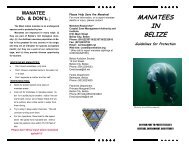The Placencia Lagoon - Coastal Zone Management Authority and ...
The Placencia Lagoon - Coastal Zone Management Authority and ...
The Placencia Lagoon - Coastal Zone Management Authority and ...
You also want an ePaper? Increase the reach of your titles
YUMPU automatically turns print PDFs into web optimized ePapers that Google loves.
CONCLUSIONS<br />
<strong>The</strong> characterization of the <strong>Placencia</strong> <strong>Lagoon</strong> was essential to put into perspective all the<br />
natural <strong>and</strong> anthropogenic factors that could affect the health <strong>and</strong> function of the<br />
estuarine system.<br />
<strong>The</strong> spatial, vertical <strong>and</strong> temporal variations in salinity distribution confirms that the<br />
<strong>Placencia</strong> <strong>Lagoon</strong> may be classified as a moderately stratified estuary.<br />
<strong>The</strong> small-scale water exchange in the upper section of the lagoon brings into prominence<br />
the vulnerability of the water body’s natural ecological <strong>and</strong> environmental conditions to<br />
excessive loadings of nutrients, organic matter <strong>and</strong> sediment.<br />
<strong>The</strong> upper section of the lagoon is not impacted by direct effluent discharge from the<br />
adjacent shrimp mariculture operations.<br />
<strong>The</strong> water quality indicators assessed in this study indicate that during the dry seasons<br />
2001 <strong>and</strong> 2003 the <strong>Placencia</strong> <strong>Lagoon</strong> displayed healthy environmental conditions.<br />
<strong>The</strong> data <strong>and</strong> results obtained in this study strongly support the hypotheses postulated.<br />
However, there is the need for more research to quantify impacts in terms of budgets for<br />
conservative <strong>and</strong> non-conservative parameters.<br />
RECOMMENDATIONS<br />
Cognizant of the invaluable natural ecological services <strong>and</strong> socioeconomic benefits<br />
provided by the <strong>Placencia</strong> estuarine system, it is appropriate to make several<br />
recommendations.<br />
Firstly, a reliable environmental quality-monitoring program needs to be implemented<br />
<strong>and</strong> sustained in the <strong>Placencia</strong> <strong>Lagoon</strong>. However, most regulatory authorities are faced<br />
with both financial <strong>and</strong> human resources constraints hence, it is incumbent on the local<br />
NGOs <strong>and</strong> residents to be involved in such a program.<br />
Secondly, the local village councils should liaise closely with the Department of the<br />
Environment to ensure that the major developments are compliant with mitigatory<br />
measures <strong>and</strong> national effluent regulations.<br />
Thirdly, the environmental NGOs should assume the lead role in educational programs to<br />
heighten the residents’ awareness about the importance <strong>and</strong> also the vulnerability of the<br />
<strong>Placencia</strong> <strong>Lagoon</strong>.<br />
Lastly, in view of the low water exchange in the upper portion of the <strong>Placencia</strong> <strong>Lagoon</strong>, it<br />
is imperative that future development are planned to ensure the lowest possible impact on<br />
the estuary.<br />
29



